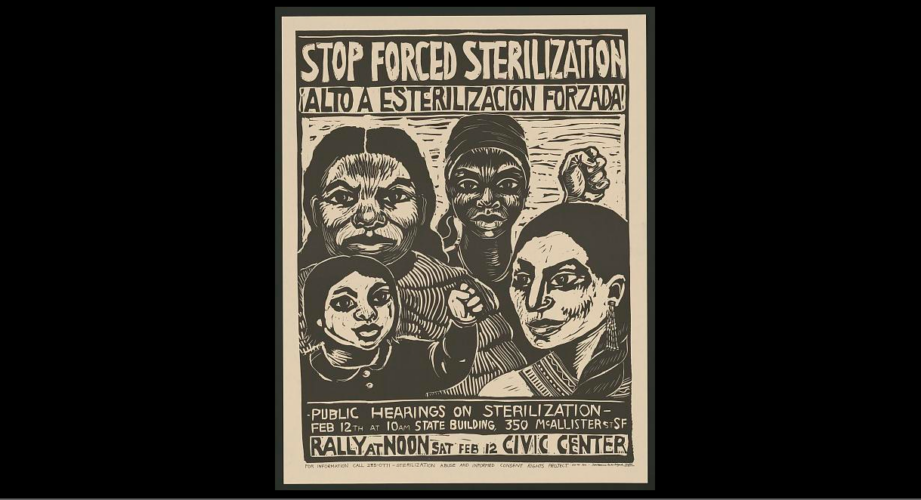
Poster for a 1971 rally against forced sterilization in San Francisco designed by Rachael Romero. (Library of Congress)
Written by Ben Hensley
What happens when a marketing agency has a campaign, but does not know its target audience?
Jane Olvera, founder and president of Fresno-based JP Marketing, is finding out. She explains that searching for clients, or in this case, potential victims of forced sterilization programs, poses a unique challenge to the company — marketing to a demographic that may not know that they are being targeted.
Throughout much of the 20th century, specifically from 1909 until 1979, and again in the late 1990s and into the 2000s, California prison inmates, specifically women, were targeted in forced sterilization efforts.
The reasons provided for the procedures varied from case to case, but during this time, an unknown number of inmates in California prisons underwent the treatments only to discover years later that they were unable to bear children.
In 2021, California Governor Gavin Newsom issued a new program creating a compensation package intended for victims of the state-sponsored sterilizations, providing $4.5 million to be split evenly among the estimated 800 living victims of forced sterilizations.
“California is committed to confronting this dark chapter in the state’s past and addressing the impacts of this shameful history still being felt by Californians today,” said Governor Newsom in the original press release on Dec. 31, 2021. “While we can never fully make amends for what they’ve endured, the state will do all it can to ensure the survivors of wrongful sterilization receive compensation.”
Late last year, however, the state sought assistance from marketing firms, opening applications to firms throughout the state in the hopes of identifying and compensating victims before the Dec. 31, 2023, deadline.
Olvera said that despite the challenge of creating a campaign for a target audience that the agency has no database on, she welcomed the challenge as an opportunity to not only improve the business, but potentially improve lives as well.
“We decided that based on our previous work and some of our digital campaigns where we have learned strategies for getting laser focused digitally, we thought we could apply that to this particular campaign,” she said. “We also love the campaigns where we can make a difference in someone’s life.”
Finding the lives that could be changed is the challenge.
The sensitivity of the topic creates a unique challenge for the agency, with Olvera adding that not only is sensitivity to the victims required, but sensitivity in regard to the state government as well.
“We don’t know where that person’s headspace is right now, and the last thing that we want to do is cause any distress or further concern for the target audience,” Olvera said. “It has been really an exercise in sensitivity on both sides — word choice and image choice has been meticulously considered.”
Another challenge that this campaign brings is the need to receive responses from potential victims. Olvera said the agency was able to work on a similar project last year, requiring not only accessible advertising and information, but also requiring action on the part of the target audience.
“Ultimately, in many cases, I’m trying to get them to actually take action,” she said. “More than just a social post, I need you to fill out a form, in this case for the Victims Compensation Board.”
Last year, JP Marketing partnered with the California Department of Public Health (CDPH) on a campaign addressing Black infant mortality rates, during which they encountered a similar challenge — reaching a target audience about a potentially sensitive topic that required further action on the part of the victim.
This time, besides attempts to focus marketing efforts in areas around state facilities where sterilization was performed, it will truly be a difficult task, but one that Olvera says the agency is up for.
“It’s a needle in a haystack,” she said. “Which is why we were so encouraged with our early results. We kept trying to reassure ourselves that if we could get a dozen [responses] we’d be happy.”
A pilot program launched at the end of last year saw 73 applications received within the final two months of the year, giving Olvera and JP Marketing a sign that they were on the right track.
Besides areas located around state facilities, Olvera added that the only other demographic the agency has to focus on is potential age ranges.
“Outside of that, there’s not a lot of variable data that I can work with,” she said.
The state has provided $276,000 toward the campaign, which will primarily be featured in English and Spanish and will be visible via Facebook, Instagram and Google platforms.
“There may be some look into using YouTube,” she said, adding that their primary platform is, “pretty heavily on the social [media] side.”
Survivors of forced sterilization can confidentially apply for compensation by visiting www.victims.ca.gov/fiscp and can also reach CalVBC at 800-777-9229 or fiscp@victims.ca.gov.








